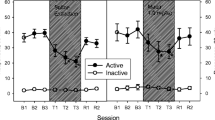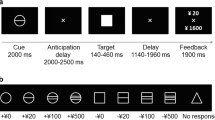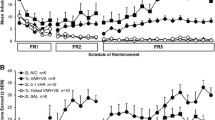Abstract
Rationale
Bupropion is an atypical antidepressant and the only non-nicotine-based therapy approved for smoking cessation. Its use has raised much debate as to how a non-nicotine-based agent can aid in smoking cessation.
Objectives
We assessed the effects of bupropion on brain reward function under baseline conditions and subsequent to withdrawal from chronic nicotine administration in rats.
Methods
A discrete-trial intracranial self-stimulation paradigm procedure was used that provides one with current intensity thresholds, a measure of reward in rats under baseline conditions and subsequent to withdrawal from chronic nicotine (3.16 mg/kg per day for 7 days via osmotic minipump). Somatic signs were recorded based on a checklist of nicotine abstinence signs in animals withdrawn from nicotine.
Results
Bupropion (10–60 mg/kg) dose-dependently lowered reward thresholds in non-withdrawing subjects indicating an increase in reward. Interestingly, a sub-effective dose of bupropion (5 mg/kg) blocked completely the threshold lowering effects of acute nicotine (0.25 mg/kg). Animals withdrawn from chronic nicotine exhibited increases in somatic signs of withdrawal and elevated brain reward thresholds, which is indicative of "diminished interest or pleasure" (i.e. anhedonia) in the rewarding stimuli. Bupropion (10–40 mg/kg) reversed both the reward deficit and the somatic signs, with the highest dose (40 mg/kg) inducing a protracted reversal of the threshold elevation.
Conclusions
Bupropion acts on multiple levels to alter brain reward circuits influenced by nicotine, in addition to reducing the expression of somatic signs of withdrawal. First, bupropion, unlike other antidepressants, increases brain reward function under baseline conditions in non-withdrawing subjects. Second, at low doses bupropion blocks the rewarding effects of nicotine. Third, bupropion reverses the negative affective aspects of nicotine withdrawal. Such actions are likely to act in concert to mediate the unique anti-smoking properties of bupropion.





Similar content being viewed by others
References
Ahluwalia JS, Harris KJ, Catley D, Okuyemi KS, Mayo MS (2002) Sustained-release bupropion for smoking cessation in African Americans: a randomized controlled trial. JAMA 288:468–474
Anda RF, Williamson DF, Escobedo LG, Mast EE, Giovino GA, Remington PL (1990 Depression and the dynamics of smoking. A national perspective. JAMA 264:1541–1545
Ascher JA, Cole JO, Colin JN, Feighner JP, Ferris RM, Fibiger HC, Golden RN, Martin P, Potter WZ, Richelson E et al. (1995) Bupropion: a review of its mechanism of antidepressant activity. J Clin Psychiatry 56:395–401
Atrens DM, Ungerstedt U, Ljungberg T (1977) Specific inhibition of hypothalamic self-stimulation by selective reuptake blockade of either 5-hydroxytryptamine or noradrenaline. Psychopharmacology 52:177–80
Balfour DJ (2001) The pharmacology underlying pharmacotherapy for tobacco dependence: a focus on bupropion. Int J Clin Pract 55:53–57
Barr AM, Markou A, Phillips AG (2002) A "crash" course on psychostimulant withdrawal as a model of depression. Trends Pharmacol Sci 23:475–482
Binks SM, Murchie JK, Greenwood DT (1979) A reward-reduction model of depression using self stimulating rats: an appraisal. Pharmacol Biochem Behav 10:441–443
Breslau N, Kilbey M, Andreski P (1992) Nicotine withdrawal symptoms and psychiatric disorders: findings from an epidemiological study of young adults. Am J Psychiatry 149:464–469
Breslau N, Peterson EL, Schultz LR, Chilcoat HD, Andreski P (1998) Major depression and stages of smoking. A longitudinal investigation. Arch Gen Psychiatry 55:161–166
Cheeta S, Irvine EE, Kenny PJ, File SE (2001) The dorsal raphe nucleus is a crucial structure mediating nicotine's anxiolytic effects and the development of tolerance and withdrawal responses. Psychopharmacology 155:78–85
Cryan JF, Dalvi A, Jin SH, Hirsch BR, Lucki I, Thomas SA (2001) Use of dopamine-beta-hydroxylase-deficient mice to determine the role of norepinephrine in the mechanism of action of antidepressant drugs. J Pharmacol Exp Ther 298:651–657
Cryan JF, Markou A, Lucki I (2002) Assessing antidepressant activity in rodents: recent developments and future needs. Trends Pharmacol Sci 23:238–45
Cryan JF, Hoyer D, Markou A (2003) Withdrawal from chronic amphetamine induces depression-like behavioural effects in rodents. Biol Psychiatry 23:238–245
Dong J, Blier P (2001) Modification of norepinephrine and serotonin, but not dopamine, neuron firing by sustained bupropion treatment. Psychopharmacology 155:52–57
Epping-Jordan MP, Watkins SS, Koob GF, Markou A (1998) Dramatic decreases in brain reward function during nicotine withdrawal. Nature 393:76–9
Ferrari R, Le Novere N, Picciotto MR, Changeux JP, Zoli M (2002) Acute and long-term changes in the mesolimbic dopamine pathway after systemic or local single nicotine injections. Eur J Neurosci 15:1810–1818
Fryer JD, Lukas RJ (1999) Noncompetitive functional inhibition at diverse, human nicotinic acetylcholine receptor subtypes by bupropion, phencyclidine, and ibogaine. J Pharmacol Exp Ther 288:88–92
Garris PA, Kilpatrick M, Bunin MA, Michael D, Walker QD, Wightman RM (1999) Dissociation of dopamine release in the nucleus accumbens from intracranial self-stimulation. Nature 398:67–9
George TP, Vessicchio JC, Termine A, Bregartner TA, Feingold A, Rounsaville BJ, Kosten TR (2002) A placebo controlled trial of bupropion for smoking cessation in schizophrenia. Biol Psychiatry 52:53–61
Geyer MA, Markou A (1995) Animal models of psychiatric disoders. In: Bloom RE, Kupfer DJ (eds) Psychopharmacology: the fourth generation of progress. Raven Press, New York, pp 787–798
Geyer MA, Krebs-Thomson K, Braff DL, Swerdlow NR (2001) Pharmacological studies of prepulse inhibition models of sensorimotor gating deficits in schizophrenia: a decade in review. Psychopharmacology 156:117–154
Glassman AH, Helzer JE, Covey LS, Cottler LB, Stetner F, Tipp JE, Johnson J (1990) Smoking, smoking cessation, and major depression JAMA 264:1546–1549
Glover ED, Glover PN (2001) Pharmacologic treatments for the nicotine dependent smoker. Am J Health Behav 25:179–182
Hall FS, Stellar JR, Kelley AE (1990) Acute and chronic desipramine treatment effects on rewarding electrical stimulation of the lateral hypothalamus. Pharmacol Biochem Behav 37:277–281
Harrison AA, Liem YT, Markou A (2001a) Fluoxetine combined with a serotonin-1A receptor antagonist reversed reward deficits observed during nicotine and amphetamine withdrawal in rats. Neuropsychopharmacology 25:55–71
Harrison AA, Chevrette J, Hoyer D, Markou A (2001b) Paroxetine combined with a 5-HT1A receptor antagonist reversed amphetamine withdrawal-induced anhedonia in rats. Soc Neurosci Abstr Program Number 665.15
Harrison AA, Gasparini F, Markou A (2002) Nicotine potentiation of brain stimulation reward reversed by DHE and SCH 23390, but not by eticlopride, LY 314582 of MPEP in rats. Psychopharmacology 160:56–66
Hayford KE, Patten CA, Rummans TA, Schroeder DR, Offord KP, Croghan IT, Glover ED, Sachs DP, Hurt RD (1999) Efficacy of bupropion for smoking cessation in smokers with a former history of major depression or alcoholism. Br J Psychiatry 174:173–178
Hays JT, Hurt RD, Rigotti NA, Niaura R, Gonzales D, Durcan MJ, Sachs DP, Wolter TD, Buist AS, Johnston JA, White JD (2001) Sustained-release bupropion for pharmacologic relapse prevention after smoking cessation. A randomized, controlled trial. Ann Int Med 135:423–433
Herberg LJ, Stephens DN, Franklin KB (1976) Catecholamines and self-stimulation: evidence suggesting a reinforcing role for noradrenaline and a motivating role for dopamine. Pharmacol Biochem Behav 4:575–582
Hildebrand BE, Nomikos GG, Hertel P, Schilstrom B, Svensson TH (1998) Reduced dopamine output in the nucleus accumbens but not in the medial prefrontal cortex in rats displaying a mecamylamine-precipitated nicotine withdrawal syndrome. Brain Res 779:214–225
Hildebrand BE, Panagis G, Svensson TH, Nomikos, GG (1999) Behavioral and biochemical manifestations of mecamylamine-precipitated nicotine withdrawal in the rat: role of nicotinic receptors in the ventral tegmental area. Neuropsychopharmacology 21:560–574
Hughes JR, Gust SW, Skoog K, Keenan RM, Fenwick, JW (1991) Symptoms of tobacco withdrawal. A replication and extension. Arch Gen Psychiatry 48:52–59
Hughes JR, Goldstein MG, Hurt RD, Shiffman S (1999) Recent advances in the pharmacotherapy of smoking. JAMA 281:72–76
Hurt RD, Sachs DP, Glover ED, Offord KP, Johnston JA, Dale LC, Khayrallah MA, Schroeder DR, Glover PN, Sullivan CR et al (1997) A comparison of sustained-release bupropion and placebo for smoking cessation. N Engl J Med 337:1195–1202
Jorenby DE, Leischow SJ, Nides MA, Rennard SI, Johnston JA, Hughes AR, Smith SS, Muramoto ML, Daughton DM, Doan K, Fiore MC, Baker TB (1999) A controlled trial of sustained-release bupropion, a nicotine patch, or both for smoking cessation. N Engl J Med 340:685–691
Katz RJ, Carroll BJ (1977) Intracranial reward after Lilly 110140 (fluoxetine HCl): evidence for an inhibitory role for serotonin. Psychopharmacology 51:189–193
Kenny PJ, Markou A (2001) Neurobiology of the nicotine withdrawal syndrome. Pharmacol Biochem Behav 70:531–549
Klimek V, Zhu MY, Dilley G, Konick L, Overholser JC, Meltzer HY, May WL, Stockmeier CA, Ordway GA (2001) Effects of long-term cigarette smoking on the human locus coeruleus. Arch Gen Psychiatry 58:821–827
Kornetsky C, Esposito RU (1979) Euphorigenic drugs: effects on the reward pathways of the brain. Fed Proc 38:2473–2476
Kotlyar M, Golding M, Hatsukami DK, Jamerson BD (2001) Effect of nonnicotine pharmacotherapy on smoking behavior. Pharmacotherapy 21:1530–1548
Laje RP, Berman JA, Glassman AH (2001) Depression and nicotine: preclinical and clinical evidence for common mechanisms. Curr Psychiatry Rep 3:470–476
Lee K, Kornetsky C (1998) Acute and chronic fluoxetine treatment decreases the sensitivity of rats to rewarding brain stimulation. Pharmacol Biochem Behav 60:539–544
Lerman C, Roth D, Kaufmann V, Audrain J, Hawk L, Liu A, Niaura R, Epstein L (2002)Mediating mechanisms of the impact of bupropion in smoking cessation treatment. Drug Alcohol Depend 67:219–223
Leith NJ, Barrett RJ (1976) Amphetamine and the reward system: evidence for tolerance and post-drug depression. Psychopharmacology 46:19–25
Leonard S, Adler LE, Benhammou K, Berger R, Breese CR, Drebing C, Gault J, Lee MJ, Logel J, Olincy A, Ross RG, Stevens K, Sullivan B, Vianzon R, Virnich DE, Waldo M, Walton K, Freedman R (2001) Smoking and mental illness. Pharmacol Biochem Behav 70:561–570
Li SX, Perry KW, Wong DT (2002) Influence of fluoxetine on the ability of bupropion to modulate extracellular dopamine and norepinephrine concentrations in three mesocorticolimbic areas of rats. Neuropharmacology 42:181–190
Lin D, Koob GF, Markou A (1999) Differential effects of withdrawal from chronic amphetamine or fluoxetine administration on brain stimulation reward in the rat-interactions between the two drugs Psychopharmacology 145:283–294
Lipkus IM, Barefoot JC, Williams RB, Siegler IC (1994) Personality measures as predictors of smoking initiation and cessation in the UNC Alumni Heart Study. Health Psychol 13:149–155
Lucki I (2001) A prescription to resist proscriptions for murine models of depression. Psychopharmacology 153:395–398
Malin DH (2001) Nicotine dependence: studies with a laboratory model. Pharmacol Biochem Behav 70:551–559
Malin DH, Lake JR, Newlin-Maultsby P, Roberts LK, Lanier JG, Carter VA, Cunningham JS, Wilson OB (1992) Rodent model of nicotine abstinence syndrome. Pharmacol Biochem Behav 43:779–784
Mansvelder HD, Keath JR, McGehee DS (2002) Synaptic mechanisms underlie nicotine-induced excitability of brain reward areas. Neuron 33:905–919
Markou A, Kenny PJ (2002) Neuroadaptations to chronic exposure to drug of abuse: Relevance to depressive symptomatology seen across psychiatric diagnostic categories. Neurotox Res 4:297–313
Markou A, Koob GF (1991) Postcocaine anhedonia. An animal model of cocaine withdrawal. Neuropsychopharmacology 4:17–26
Markou A, Koob GF (1992) Construct validity of a self-stimulation threshold paradigm: effects of reward and performance manipulations. Physiol Behav 51:111–119
Markou A, Hauger RL, Koob GF (1992) Desmethylimipramine attenuates cocaine withdrawal in rats Psychopharmacology 109:305–314
Markou A, Kosten TR, Koob GF (1998) Neurobiological similarities in depression and drug dependence: a self-medication hypothesis. Neuropsychopharmacology 18:135–174
McCarter BD, Kokkinidis L (1988) The effects of long-term administration of antidepressant drugs on intracranial self-stimulation responding in rats. Pharmacol Biochem Behav 31:243–247
Meyer JH, Goulding VS, Wilson AA, Hussey D, Christensen, BK, Houle S (2002) Bupropion occupancy of the dopamine transporter is low during clinical treatment. Psychopharmacology 163:102–105
Miller DK, Sumithran SP, Dwoskin LP (2002) Bupropion inhibits nicotine-evoked [(3)H]overflow from rat striatal slices preloaded with [(3)H]dopamine and from rat hippocampal slices preloaded with [(3)H]norepinephrine. J Pharmacol Exp Ther 302:1113–1122
Nomikos GG, Damsma G, Wenkstern D, Fibiger HC (1989) Acute effects of bupropion on extracellular dopamine concentrations in rat striatum and nucleus accumbens studied by in vivo microdialysis. Neuropsychopharmacology 2:273–279
Peto R, Lopez AD, Boreham J, Thun M, Heath C Jr (1992) Mortality from tobacco in developed countries: indirect estimation from national vital statistics. Lancet 339:1268–1278
Picciotto MR, Corrigall WA (2002) Neuronal systems underlying behaviors related to nicotine addiction: neural circuits and molecular genetics. J Neurosci 22:3338–3341
Rasmussen K, Kallman MJ, Helton DR (1997) Serotonin-1A antagonists attenuate the effects of nicotine withdrawal on the auditory startle response. Synapse 27:145–152
Rasmussen K, Calligaro DO, Czachura JF, Dreshfield-Ahmad LJ, Evans DC, Hemrick-Luecke SK, Kallman MJ, Kendrick WT, Leander JD, Nelson DL, Overshiner CD, Wainscott DB, Wolff MC, Wong DT, Branchek TA, Zgombick JM, Xu YC (2000) The novel 5-hydroxytryptamine(1A) antagonist LY426965: effects on nicotine withdrawal and interactions with fluoxetine. J Pharmacol Exp Ther 294:688–700
Rose JE, Behm FM, Westman EC, Levin ED, Stein RM, Ripka GV (1994) Mecamylamine combined with nicotine skin patch facilitates smoking cessation beyond nicotine patch treatment alone. Clin Pharmacol Ther 56:86–99
Semenova S, Markou A (2003) Clozapine treatment attenuated somatic and affective signs of nicotine and amphetamine withdrawal in subsets of rats that exhibited hyposensitivity to the initial effects of clozapine. Biol Psychiatry (in press)
Seong E, Seasholtz AF, Burmeister M (2002) Mouse models for psychiatric disorders. Trends Genet 18:643–650
Shiffman S, Johnston JA, Khayrallah M, Elash CA, Gwaltney CJ, Paty JA, Gnys M, Evoniuk G, DeVeaugh-Geiss J (2000) The effect of bupropion on nicotine craving and withdrawal. Psychopharmacology 148:33–40
Skjei KL, Markou A (2003) Effects of repeated withdrawal episodes, nicotine dose, and duration of nicotine exposure on the severity and duration of nicotine withdrawal in rats. Psychopharmacology (DOI 10.1007/s00213-003-1414-1)
Slemmer JE, Martin BR, Damaj MI (2000) Bupropion is a nicotinic antagonist. J Pharmacol Exp Ther 295:321–327
Spielewoy C, Markou A (2002) Withdrawal from chronic phencylidine treatment induces long-lasting depression in brain reward function Neuropsychopharmacology (in press)
Stolerman IP, Jarvis MJ (1995) The scientific case that nicotine is addictive. Psychopharmacology 117:2–10
Tashkin D, Kanner R, Bailey W, Buist S, Anderson P, Nides M, Gonzales D, Dozier G, Patel MK, Jamerson B. (2001) Smoking cessation in patients with chronic obstructive pulmonary disease: a double-blind, placebo-controlled, randomised trial. Lancet 357:1571–1575
Watkins SS, Stinus L, Koob GF, Markou A (2000) Reward and somatic changes during precipitated nicotine withdrawal in rats: centrally and peripherally mediated effects. J Pharmacol Exp Ther 292:1053–1064
Wiley JL, Lavecchia KL, Martin BR, Damaj MI (2002) Nicotine-like discriminative stimulus effects of bupropion in rats. Exp Clin Psychopharmacol 10:129–135
Wise CD, Stein L (1969) Facilitation of brain self-stimulation by central administration of norepinephrine. Science 163:299–301
Young R, Glennon RA (2002) Nicotine and bupropion share a similar discriminative stimulus effect. Eur J Pharmacol 443:113–118
Acknowledgements
The authors would like to thank Mr. Stefan Imobersteg for technical assistance and Mr. Michael Arends for editorial assistance. This work was supported by Tobacco-Related Disease Program grant from the State of California 10RT-0074, National Institute on Drug Abuse grant DA11946, National Institute of Mental Health grant MH62527 and a Novartis Research Grant to A.M. A.W.B. was supported by Individual Postdoctoral Fellowship from the Tobacco-Related Disease Research Program from the State of California 11FT-0112. This is publication number 14934-NP from The Scripps Research Institute.
Author information
Authors and Affiliations
Corresponding author
Additional information
A.W.B. and K.L.S. contributed equally to this manuscript
Rights and permissions
About this article
Cite this article
Cryan, J.F., Bruijnzeel, A.W., Skjei, K.L. et al. Bupropion enhances brain reward function and reverses the affective and somatic aspects of nicotine withdrawal in the rat. Psychopharmacology 168, 347–358 (2003). https://doi.org/10.1007/s00213-003-1445-7
Received:
Accepted:
Published:
Issue Date:
DOI: https://doi.org/10.1007/s00213-003-1445-7




